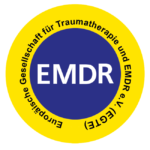
The Inner Safe Place in EMDR Sessions: Meaning, Function, and Application
EMDR (Eye Movement Desensitization and Reprocessing) is an evidence-based, highly effective method of psychotherapy that was originally developed to treat post-traumatic stress disorder (PTSD). It is based on the assumption that stressful and traumatic experiences are often not adequately processed, which can lead to lasting emotional impairments that significantly affect the lives of those affected.
A central element within the therapeutic process is the so-called “safe place” – a mental resource that serves to facilitate a state of inner calm, security and emotional stability during the sessions.
Note on EMDR self-coaching
At the EMDR self-coaching, the establishment of the Safe Place is not one of the 6 steps, as it is assumed that the user is able to move from the coaching topic at any time and to be able to calm yourself down. But even if there is no compelling need for self-coaching, setting up a Safe Place and traveling there repeatedly is always an enriching, calming and beautiful experience. A Safe Place is therefore highly recommended.
What is the safe place – and what is it for?
The safe place, also regularly referred to as the “inner safe place”, is an individually designed visualization of a place associated with positive feelings. This can be a real place familiar to the person concerned, or an imaginary place constructed in one’s own mind. The crucial aspect is that this place evokes a subjective feeling of protection, security, and relaxation.
During the EMDR sessions, the person concerned is gradually guided to build this place in their imagination, which is why the term “inner safe place” is also common. Sensory details are consciously included: What does the environment look like? What sounds can be heard? What colors, scents, and sensations can be perceived? This vivid multisensory imagination not only creates an emotionally positive counterweight to stressful memories, but also enables short-term psychological distancing in the therapeutic process.
The aim is not to repress or block out difficult memories, but to stabilize emotional resilience during the process. The safe place acts as a mental retreat that can be accessed in a targeted manner to strengthen emotional self-regulation.
Integration into the EMDR process
 During a typical EMDR session, the affected person is instructed to focus on specific distressing memories. At the same time, bilateral stimulation techniques are used – such as visual stimuli through eye movements or auditory stimuli via alternating tones in both ears. This bilateral stimulation serves to promote neuronal processing and integration of the memories.
During a typical EMDR session, the affected person is instructed to focus on specific distressing memories. At the same time, bilateral stimulation techniques are used – such as visual stimuli through eye movements or auditory stimuli via alternating tones in both ears. This bilateral stimulation serves to promote neuronal processing and integration of the memories.
In this context, the inner safe place serves a dual function: it can be used as preparation to build a trusting basic stability, and during the session, it can be drawn upon as an active coping resource if emotional overwhelm occurs. The ability to retreat internally into a protected state during a distressing moment significantly contributes to being able to continue the process and maintain emotional stability.
Also effective outside of therapy
The use of the safe place is not limited to therapy sessions. Rather, this technique can be used in everyday life as a proven self-soothing strategy – for example in acute stress situations, panic symptoms or emotional overstimulation. The safe place acts as a tool that can be activated at any time to mobilize your own emotional resources and find your way back to a state of inner calm.
A place that heals and strengthens
The safe place is far more than a simple imagination exercise. As a structured component of EMDR therapy, it makes a significant contribution to the processing of traumatic experiences by creating emotional security, supporting self-regulation, and strengthening the feeling of inner control. Through the connection with bilateral stimulation techniques, this protected inner space can help not only to create short-term relief, but also to promote long-term healing processes.
How the safe place is established as part of EMDR therapy
Establishing a so-called “inner safe place” is a significant preparatory step within an EMDR session. This imagined or remembered refuge serves as an emotional retreat that the person concerned can access during the therapeutic process to restore inner calm and psychological stability. The safe place is established under the guidance of the therapist and is individually tailored to the patient’s needs and resources.
Introduction and goal clarification by the therapist
At the beginning of the session, the therapist explains the function and therapeutic benefits of the safe place. He makes it clear that it is a place where the person concerned can feel safe, secure and relaxed. The patient is invited to choose a place that has a positive meaning for them personally. This can be a real, familiar place or an imaginary environment that is constructed entirely in the imagination.
Guided visualization and sensory deepening
 The therapist supports the visual imagination by asking specific questions: What does this place look like? What colors, shapes or scenic elements are present? Are there characteristic sounds, certain scents or tangible textures? The aim is to promote the most vivid and sensually enriched imagination possible. The conscious activation of different sensory channels makes it easier to establish an emotionally effective connection to the safe place.
The therapist supports the visual imagination by asking specific questions: What does this place look like? What colors, shapes or scenic elements are present? Are there characteristic sounds, certain scents or tangible textures? The aim is to promote the most vivid and sensually enriched imagination possible. The conscious activation of different sensory channels makes it easier to establish an emotionally effective connection to the safe place.
As soon as the visualization is in place, the person concerned is encouraged to consciously perceive the associated emotional sensations. In particular, the experience of inner peace, security and relief should be emphasized and reinforced. The therapist accompanies this process attentively and instructs the person to concentrate specifically on these positive emotional states.
Deepening and anchoring the safe place
To further stabilize the emotional connection to the safe place, additional body-related or symbolic elements can be integrated. For example, the therapist can suggest performing a symbolic gesture – such as holding an imaginary object or touching a certain area of the body – to anchor the experience physically. Introducing positive inner sentences or affirmations associated with the safe place can also reinforce the effect and increase accessibility.
These techniques serve to anchor the safe place in the emotional memory in the long term. They make it possible to reliably activate this place in later sessions or in stressful everyday situations.
Sustainable availability in a therapeutic and everyday context
At the end of the session, it is ensured that the patient is able to access the safe space independently if required. The therapist recommends consciously using this inner space not only during therapy, but also outside of it – for example in moments of emotional tension, sleep problems or in situations of increased psychological stress.
It should be noted that the specific procedure for establishing the safe place can vary depending on the therapist, therapeutic school and individual requirements of the patient. The intervention is always flexibly adapted to the personal experience and imagination of the person concerned.
An individually designed shelter
Establishing a safe place is a resource-oriented intervention within EMDR therapy. The conscious activation of positive inner images and the integration of sensory and emotional levels creates an inner protective space that contributes to stabilization, self-regulation and the long-term promotion of resilience. Properly guided and individually designed, the safe space becomes an inner anchor that is available at all times – both in therapy and in everyday life.
Example of the establishment of a safe place
The therapist says:
“Now let’s start the process of your safe place together. Close your eyes and take a comfortable position. Feel your breath and let your body slowly calm down. Imagine that you are in a place that gives you a deep sense of safety and security.
Imagine yourself in a beautiful, secluded place. It could be a real place that you know and that evokes positive feelings in you, or you could create a completely new place in your imagination. It’s a place that gives you a sense of calm and security – a place where you feel completely relaxed and protected.
Look at the surroundings of this place. Which colors dominate? Are there soft greens of nature, calming blues of the water or warm earth tones? Let these colors come to life and feel how they evoke a sense of relaxation and well-being in you.
Now draw your attention to the sounds. Listen to the sounds that make up this place. Perhaps you hear the gentle sound of the sea, the chirping of birds in the trees or the rustling of leaves in the wind. Let these sounds fill your senses and feel how they give you a sense of security.
Breathe in deeply and take in the scent of this place. Perhaps you smell the fresh scent of flowers, the earthy aroma of the forest or the salty sea in the air. Allow yourself to breathe in this scent deeply and feel how it calms and relaxes you inside.
Now explore this place further. Notice the details that surround you. Feel the texture of the ground under your feet, the gentle breeze on your skin, the warm sun on your face. Take it all in and let this image take shape in your mind.
This place that you create in your imagination is your safe place. A place that you can visit at any time to calm down and regain your balance. A place where you feel safe and secure – free from any stress and anxiety.
When you are ready, slowly open your eyes and return to the room. Keep the idea of your safe place present in your mind, and know that you can return to it again and again to find peace and stability – both during our EMDR sessions and in everyday life.”
Note:
It should be noted that this monologue serves as an example and an actual therapist would respond individually to the patient’s needs and preferences to support the safe place process.
The safe place: origins and theoretical foundations
The conception of a so-called “safe place” in both psychotherapy and coaching is based on various theoretical currents and therapeutic approaches. The influence of Neuro-Linguistic Programming (NLP) is particularly formative – a model that deals with the interaction between thinking, language and behavior.
Visualization plays a central role within NLP. The aim is to promote neuronal activation processes through consciously generated inner images, which can lead to positive changes in emotional experience and behavior. This technique is also the basis for developing a safe place: targeted imagination strengthens neural connections and anchors positive experiences internally.
However, the integration of the safe place cannot be attributed exclusively to NLP. Rather, it is a transdisciplinary concept that is used in various therapeutic approaches. It gained particular significance through EMDR therapy (Eye Movement Desensitization and Reprocessing), developed by the psychologist Francine Shapiro in the late 1980s. The EMDR method has since established itself as an evidence-based procedure in the treatment of trauma-related disorders and systematizes the safe place as a central component of stabilization.
In the context of EMDR, it is assumed that traumatic experiences put the nervous system in a state of overexcitation, making it difficult to access inner resources. In such moments, the safe place creates a protected mental space in which relaxation, security and emotional regulation are possible. It thus actively supports the re-integration of self-efficacy and inner stability.
The safe place as a multi-sensory experience
The effectiveness of the safe place is essentially based on the inclusion of several sensory channels. A holistic and emotionally meaningful presentation is particularly successful when as many dimensions of perception as possible are addressed.
- Visual imagination: Colors, shapes, lighting conditions and spatial details of the place are brought to life in the inner imagination.
- Auditory components: Natural sounds such as the sound of water, birdsong or rustling leaves lend depth to the performance.
- Kinesthetic experience: Physical sensations – floor, temperature, wind – strengthen the realistic perception of the place.
- Olfactory elements: Scents such as forest, sea or flowers activate emotional memories in the limbic system.
- Haptic imagination: The imaginary feeling of surfaces such as grass or water can have a calming and stabilizing effect.
Conclusion: The depth of a safe inner space
 The creation of a safe place is based on an integrative interplay of different therapeutic concepts – in particular from NLP and EMDR therapy. The multisensory construction of this inner retreat space not only enables intensive emotional anchoring, but also specifically supports access to stabilizing resources.
The creation of a safe place is based on an integrative interplay of different therapeutic concepts – in particular from NLP and EMDR therapy. The multisensory construction of this inner retreat space not only enables intensive emotional anchoring, but also specifically supports access to stabilizing resources.
By consciously involving all the senses, the safe place becomes a vivid inner experience that can have a tangible effect in both therapeutic and everyday contexts. It helps to find emotional stability in challenging situations and restore access to inner peace and self-efficacy.
























